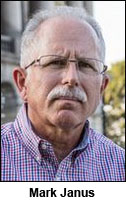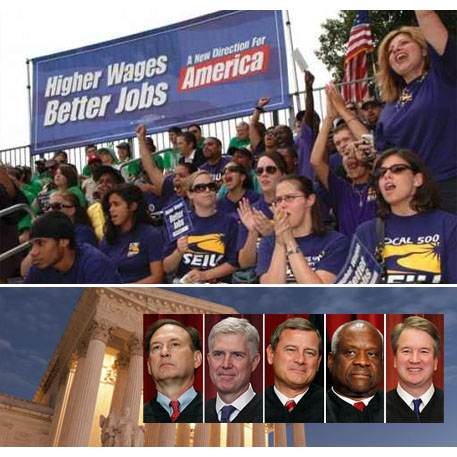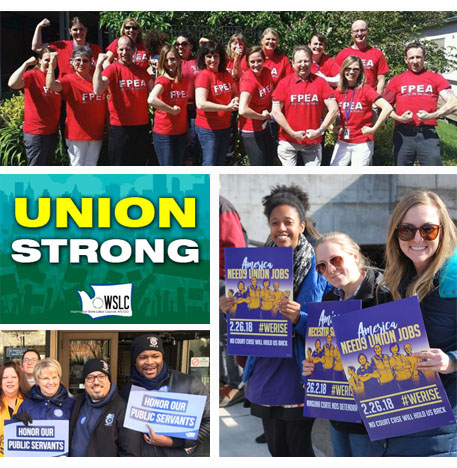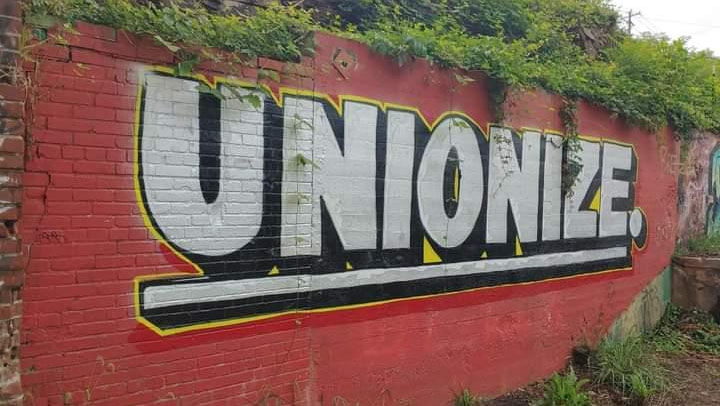OPINION
5 years after Janus, unions still going strong
Right-wing conservatives hoped 2018 Supreme Court decision would kneecap public sector unions. They were wrong.
By MICHAEL ARTZ
(Nov. 6, 2023) — Janus v. AFSCME Council 31 turned five years old this past June. Happy birthday to the Supreme Court case that twisted the interpretation of the First Amendment away from the freedom of association principles that protect workers’ rights to join labor unions and instead toward an interpretation of freedom of speech that now prohibits public sector unions from charging fees to nonmembers for union representation provided.
 A lot has happened in the five years since Justice Samuel Alito authored the decision, decided 5-4 along the frequent conservative/liberal split seen in important Supreme Court decisions. Two justices have retired. One has passed away. A president has been impeached, twice. Mark Janus, the named plaintiff in the case, and reflecting perhaps the two-faced Roman god who shares his name, left his job working for the Illinois Department of Healthcare and Family Services and took a position as a senior fellow at the Liberty Justice Center, a conservative anti-union organization that played an outsized role in bringing the case before the Supreme Court.
A lot has happened in the five years since Justice Samuel Alito authored the decision, decided 5-4 along the frequent conservative/liberal split seen in important Supreme Court decisions. Two justices have retired. One has passed away. A president has been impeached, twice. Mark Janus, the named plaintiff in the case, and reflecting perhaps the two-faced Roman god who shares his name, left his job working for the Illinois Department of Healthcare and Family Services and took a position as a senior fellow at the Liberty Justice Center, a conservative anti-union organization that played an outsized role in bringing the case before the Supreme Court.
Some things have not changed. Bruce Rauner, former republican governor of Illinois who brought the original case, is still a billionaire. And public sector unions continue to survive and even grow. What did not happen was the predicted crippling of public sector unions, hoped for by those who celebrated the Janus decision.
The Janus case was the third and final act in a trilogy of cases aimed at eliminating what are called “fair share fees” or “agency fees” within public sector unions. A fair share fee is a percentage of total union dues paid by an employee covered by a collective bargaining agreement but who chooses not to join the union as a member. The fee cannot be used for political purposes and is paid to the union for the services provided to the employee through collective bargaining and for the administration of the contract.
These fees are “fair” because even though a majority of employees in a workplace voted to have a union represent them, by law, a union is required to represent all the employees in the bargaining unit whether or not those employees have exercised their option to be full-fledged dues-paying union members. This legal obligation is called the “duty of fair representation.” Without those fees, the union is forced, at great cost, to represent nonmembers for free. Fair share fees make sure the cost of negotiating benefits is shared by all employees who receive the benefits of a union contract. If too many members opt out to receive the benefit of the union for free, the union itself might eventually collapse under the weight of required service without the resources needed to provide it.
 To Justice Alito and his like-minded colleagues on the Court, fair share fees are an affront to the First Amendment as a form of compelled speech. To them, the fees aren’t about sharing the cost of a service but about “public employees . . . forced to subsidize a union, even if they choose not to join and strongly object to the positions the union takes in collective bargaining and related activities.”
To Justice Alito and his like-minded colleagues on the Court, fair share fees are an affront to the First Amendment as a form of compelled speech. To them, the fees aren’t about sharing the cost of a service but about “public employees . . . forced to subsidize a union, even if they choose not to join and strongly object to the positions the union takes in collective bargaining and related activities.”
To render fair share fees unconstitutional, the Supreme Court first had to reckon with the 40-plus-year-old unanimous Abood v. Detroit Board of Education (431 U.S. 209 (1977)) opinion, which held that fair share fees in the public sector did not violate the First Amendment. The Abood court recognized that the fees did not require employees to support causes or activities unrelated to collective bargaining and that the system promotes industrial peace and stabilizes labor-management relations.
Justice Alito first referred to fair share fees as “an anomaly” in the 2012 Knox v. Service Employees International Union (567 U.S. 298) case involving a union implementing a special assessment fee. The Supreme Court then expressly whittled away at Abood in 2014 in the Harris v. Quinn case, also an Alito-authored 5–4 decision. This case concerned home health care workers represented by the Service Employees International Union who provide personal care assistance to the elderly and infirm. The National Right to Work Foundation, an anti-union organization, filed suit arguing that fair share fees in the public sector violate the First Amendment. Alito in his opinion dodged that question by characterizing the home health care workers as “partial” or “quasi” public employees rather than “full-fledged” employees, not covered by Abood. However, Alito used the opinion to foreshadow his arguments as to why Abood should be overturned in the future if the right case came before the Court.
Next came a case called Friedrichs v. California Teachers Association (578 U.S. ___ (2016)), an explicit vehicle to overturn Abood. Justice Antonin Scalia spoiled that effort by shuffling off his mortal coil between oral arguments and the issued decision, which left only eight justices on the Supreme Court. Ties go to the lower court, and four justices to four left the Ninth Circuit’s upholding of fair share fees to stand.
Finally, in the summer of 2018, Justice Alito got his case, and with the help of Justice Anthony Kennedy singing his pre-retirement swansong, and support from Justices John Roberts, Clarence Thomas, and Neil Gorsuch, the Court overturned Abood and outlawed public sector fair share fees.
The anti-union conservative organizations gloated over the decision. The National Right to Work Foundation described Janus as “a massive step forward in the fight to protect American workers from forced unionism.” They boasted of depriving unions of hundreds of millions of dollars.
 These organizations also immediately got to work attempting to convince public sector union members their time had come to drop their membership. Some, like the conservative Mackinac Center for Public Policy, set up a drop-your-dues hotline. The Freedom Foundation, part of the State Policy Network of corporate-funded conservative groups, and other anti-union groups, engaged in an intense campaign to convince public sector union members to drop their membership and become free riders, including mailings, canvassing, door knocking, and worksite visits.
These organizations also immediately got to work attempting to convince public sector union members their time had come to drop their membership. Some, like the conservative Mackinac Center for Public Policy, set up a drop-your-dues hotline. The Freedom Foundation, part of the State Policy Network of corporate-funded conservative groups, and other anti-union groups, engaged in an intense campaign to convince public sector union members to drop their membership and become free riders, including mailings, canvassing, door knocking, and worksite visits.
The “drop campaigns” failed to make a significant dent in public sector union membership numbers. As the American Federation of State, County and Municipal Employees (AFSCME) President Lee Saunders has noted, “anyone writing [union’s] obituary is going to be sorely disappointed.”The numbers reported by the U.S. Bureau of Labor Statistics (BLS) demonstrate just how weak the Janus impact has been. For example, from 2018 when Janus was decided to the following year 2019, local (cities, counties, and other local jurisdictions) public sector union membership went down about 1 percent from 40.3 percent to 39.4 percent. For state government workers, however, the percentage went up from 28.6 percent to 29.4 percent—hardly the death knell hoped for by the anti-union entities.
Overall, the decline in the union membership rate in the public sector from 2018 to 2019 was a paltry .3 percent (about 100,000 members), about on par with the private sector decline at .2 percent. The slight decline also correlates to the decline in the total number of public sector jobs available. Those in favor of the Janus decision were forced to admit the lack of the decision’s reach. The Freedom Foundation noted only a slight decline in public sector union membership in 2018. An April 2022 report from the Manhattan Institute, another conservative organization, reported largely flat membership rates from 2018 to 2022. Per the BLS year-end 2022 report, public sector union membership declined by only .8 percent from 2021. And according to internal union reports, the rate of fair share fee payers becoming full-fledged dues-paying members outpaces those dropping membership at a rate of five to one.
 The reason for the lack of severe membership losses in the wake of the Janus decision may be that unions prepared for and reacted to the decision in several proactive ways. AFSCME, for example, beginning after the Harris and Friedrichs decisions, implemented an internal organizing program called “AFSCME Strong,” which prioritized one-on-one communications, member-to-member engagement, new computer technology to aid organizing and sign-up, and more political engagement to pass laws allowing for better access to worksites and potential members.
The reason for the lack of severe membership losses in the wake of the Janus decision may be that unions prepared for and reacted to the decision in several proactive ways. AFSCME, for example, beginning after the Harris and Friedrichs decisions, implemented an internal organizing program called “AFSCME Strong,” which prioritized one-on-one communications, member-to-member engagement, new computer technology to aid organizing and sign-up, and more political engagement to pass laws allowing for better access to worksites and potential members.
Other public sector unions made similar efforts, and by inoculating and organizing, the drop campaigns failed to resonate with workers. By convincing existing members of the value of their union, persuading some nonmembers to join, and recruiting new hires into the union, these unions softened the blow. Unions reminded workers that public sector union members make 11 to 14 percent more than nonunion members similarly situated and are more likely to have health insurance, paid sick days, paid vacation days and holidays, and retirement benefits.
Meanwhile, the right-wing organization’s litigation strategy post-Janus has widely failed. Anti-union groups have filed close to 200 lawsuits in state and federal courts. To date, not a single court has ruled in their favor, although a handful are pending certiorari at the Supreme Court. These lawsuits have unsuccessfully advanced numerous theories to recoup past dues payments, end exclusive representation in the public sector, challenge maintenance of membership language on membership cards, and allege similar First Amendment arguments made in the Janus case.

Moreover, the overall climate and public opinion about unions have changed since 2018. Since Janus, the excitement level about unions and collective action in the workplace is at historically high levels. A widely reported 2021 Gallup poll showed the union approval rate at 68 percent, the highest since 1965. Workers in the public and private sectors are engaging in more workplace actions, more strikes, and more organizing campaigns in their workplaces. With this developing culture of union support and approval, perhaps public sector union members also viewed the Janus decision as a naked political attack on their unions, one that damaged the Supreme Court’s reputation and legitimacy, which continues to this day.
The observation from the Abood opinion back in the 1970s that prohibiting fair share fees could lead to less labor peace has proven to be correct. Without stable collective bargaining regimes within workplaces, workers and their unions will engage in more disruptive strategies and tactics to allow workers to have a voice within their workplaces. October 2021 was nicknamed Strike-tober. Large-scale strikes or other work stoppages sparked at John Deere, Kellogg’s, and other large employers. Fifteen-thousand hotel workers in Southern California were on strike in late June into July 2023. Writers and actors are on strike. High-profile union victories after work actions have been seen at Amazon, Starbucks, and UPS.
Perhaps Janus was a labor movement wake-up call, not a termination notice.
 Michael Artz is Associate General Counsel for the American Federation of State, County and Municipal Employees (AFSCME). This column, which was first published in the American Bar Association’s Human Rights magazine, is posted here with the author’s permission.
Michael Artz is Associate General Counsel for the American Federation of State, County and Municipal Employees (AFSCME). This column, which was first published in the American Bar Association’s Human Rights magazine, is posted here with the author’s permission.





